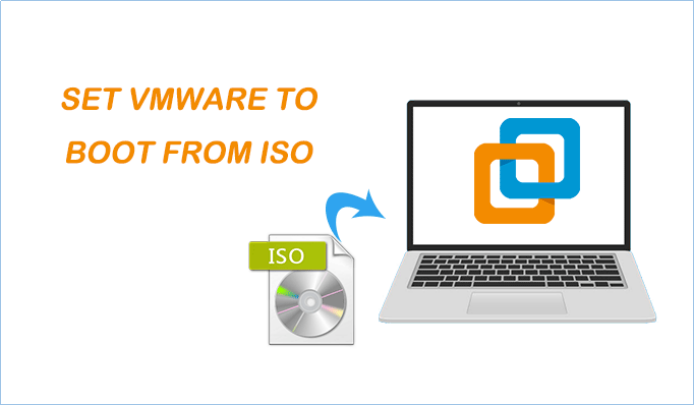How to Create an ISO Image for a Virtual Machine
Gap updated on Jul 02, 2024 to Todo Backup Guide | How-to Articles
Learn how to create an iSO image for a virtual machine with this guide. It covers the steps for Linux and Windows users to convert VMDK files for easy data transfer. The article also explains Virtual-to-Physical conversions using EaseUS Todo Backup, offering a roadmap for both tasks.
Creating an ISO image from a virtual machine doesn't come with a wide array of options. If you're a Linux user, you can convert VMDK to ISO utilizing commands such as 'dd' and 'qemu-img'. However, Windows users will need to depend on third-party software to accomplish this task.
If your primary objective is to carry out a Virtual-to-Physical conversion, options become more plentiful. You can opt to back up the entire system and then restore it to a physical machine. In this article, both these processes, converting a VM to ISO and performing a V2P conversion, will be explored in detail.

An ISO image is a file that contains an exact, byte-for-byte copy of a disk. It captures everything on the disk, including the file system information, the data, and the bootable elements. In essence, it's a complete snapshot of your virtual machine that can be stored and used for future backups, software distribution, or system recovery.
Step 1: Install QEMU
QEMU is a generic and open source machine emulator and virtualizer. To install it on Ubuntu, use the following command:
sudo apt-get install qemu-utils
For CentOS or Fedora, use:
sudo yum install qemu-img
Step 2: Convert VM Disk to Raw Format
In this step, we will convert the VM disk into a raw format using qemu-img.
qemu-img convert -f vmdk -O raw source.vmdk target.raw
In this command:
Step 3: Convert Raw to ISO
Now, we will convert the raw disk image file to ISO using the dd command:
dd if=target.raw of=target.iso
In this command:
Note: you need root permissions to execute these commands.
EaseUS Todo Backup is a comprehensive and reliable backup and recovery solution which provides a wide range of advanced features and capabilities that effectively safeguard critical data, minimize downtime, and guarantee uninterrupted business operations. It enables you to physicalize the virtual machines with a few steps.
Create a System Image from the Virtual Machine
Step 1. Open EaseUS Todo Backup Enterprise. Then click "New Task" to set a new backup.
Step 2. Choose "Disk/Volume" as the target among the options at the top. Then select the system to back up.
Step 3. Then click "Browser" to choose the destination where you want to put the backup.
Step 4. You can customize your backup scheme by clicking "Schedule: Off". Here you can see "Schedule", "Backup cleanup" and "Adcanced Settings". Click "New" under the "Schedule" catalog.
Then set the backup frequency based on your needs.
Step 5. Click "Backup options" on the bottom-left corner of the interface.
You can change the performance, encryption, e-mail notification, and other options here according to your preferences. When finish, click "Save" to return to the main interface.
Step 6. When you finish all settings, click "Proceed" to start backing up system.
Restore a Virtual System Image to a Physical Machine
Step 1. Launch EaseUS Todo Backup on your computer. Click on the "Recovery" button.
Step 2.Click the "Browser" button on the top-right corner.
Step 3. A window about recovery will come out. Find and choose the backup system you need to recover, then click "OK".
Step 4. Select a location to restore the backup to. Then click on "Proceed" button and the recovery begins.
Creating an ISO image from a virtual machine using EaseUS Todo Backup is a relatively easy task. This method provides an efficient way of ensuring that your virtual environment is properly backed up. Remember, in a digital era where data is king, securing your data with backups like an ISO image is not just smart; it is essential.
1. Can I create an ISO image from a virtual machine on any operating system?
Yes, you can create an ISO image from a VM on any operating system, including Windows, Linux, and macOS. However, the process might vary depending on the operating system and the software you use.
2. Do I need special software to create an ISO image from a VM?
While you don't necessarily need special software to create an ISO image from a VM, using software like EaseUS Todo Backup or QEMU can simplify the process.
3. How can I use the ISO image after creating it?
Once you have created an ISO image, you can use it to install the VM on another system, burn it to a CD/DVD for physical storage, or keep it as a backup.
4. Can I create an ISO image from a VM if I'm not tech-savvy?
Yes, despite seeming complicated, the process can be quite straightforward, especially if you use user-friendly software. It's always best to follow a step-by-step guide to ensure you don't miss any important steps.
5. How long does it take to create an ISO image from a VM?
The length of time it takes to create an ISO image from a VM depends on the size of the VM and the speed of your computer. However, with a reasonably modern machine, it should typically take from a few minutes to an hour.
Related Articles
Full Guide to Perform Windows Server Backup Bare Metal Recovery [2024]
How to Automatically Clone A Hard Drive as A Backup for A PC
A Complete Guide to Windows Server Backup and Restore [2024 Update]
How to Take SQL Server Database Backup Using Command Prompt